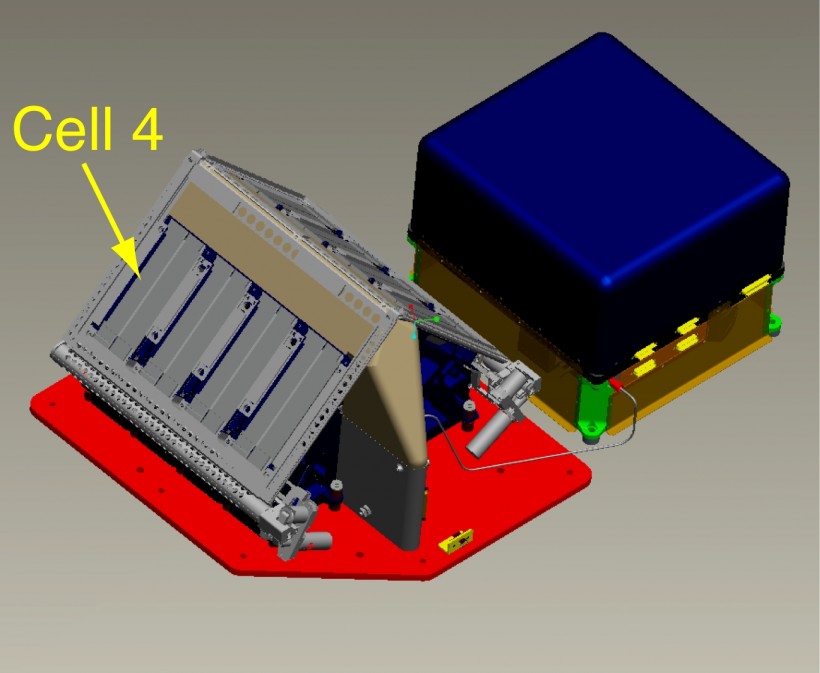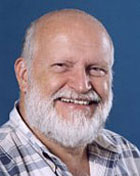When Bill Boynton announced at a Phoenix lander team meeting earlier today that the troublesome, clumpy Martian soil now sits, finally, within the TEGA “oven” on Phoenix, the room erupted with cheers and a standing ovation. Boynton then launched a rendition of “Shake, Shake, Shake” he had cued-up on his laptop, and started dancing. If that mental image doesn’t make it clear, getting the soil into TEGA is big, and the entire Phoenix team is excited about the accomplishment. Boynton, who leads the investigations with the Thermal and Evolved Gas Analyzer instrument, and his team have been trying various methods for several days to get the stubborn soil through a screen and into TEGA. The instrument will heat the soil and analyze the gases released to check for water vapor and other chemicals in the soil.
Commands to vibrate the screen were sent to Phoenix for three separate days. Boynton said that the oven might have filled because of the cumulative effects of all the vibrating, or because of changes in the soil’s cohesiveness as it sat for days on the top of the screen.
“There’s something very unusual about this soil, from a place on Mars we’ve never been before,” said Phoenix Principal Investigator Peter Smith. “We’re interested in learning what sort of chemical and mineral activity has caused the particles to clump and stick together.”
Between the shaking and the other new technique developed with the robotic arm called “sprinkling,” Smith hopes they won’t encounter future problems with getting the soil where they want it to go. “Delivering the soil is something we’re getting better at everyday,” he added.
Tomorrow, Thursday June 12, commands will be sent for the TEGA to heat the soil. Initial results may be available on Friday.
“We’ll do a low temperature bake that will tell us how much ice is in the soil,” said Boynton. ” We really don’t expect there to be much ice in the soil since it has been sitting out in the sun and vibrated through the screen. It does look like the soil has changed.”
TEGA has eight ovens to “bake” soil samples. Once an oven is used, it can’t be emptied and used again, so Phoenix has just eight chances to analyze the soil.
While there’s been some debate about the characteristics of Martian arctic soil, Smith said most researchers on the Phoenix team believe it’s a matter of when and not if Phoenix will definitely prove there is water ice region the lander sits on. “There are very few people who don’t believe there’s ice under the soil,” he said. “There also could be a crusty layer of salt on top because of evaporation.”
“We all have a lot of confidence we’ll get down to the ice,” Boynton added. “We may have exposed some in the act of landing. The MECA instrument will help the debate on salt. In a week or two we hope to get enough data to address these speculations.”
MECA is the Microscopy, Electrochemistry, and Conductivity Analyzer, which contains four single wet chemistry labs that will dissolve small amounts of soil in water, to determine the pH and what minerals are in the soil. Those tests will be done later in the mission.
Plans for today’s activities for Phoenix include sprinkling Martian soil on the delivery port for the spacecraft’s Optical Microscope and taking additional photos for a high-resolution color panorama of the lander’s surroundings.
Original News Sources: Phoenix press conference, Phoenix press release



The instrument will heat the soil and analyze the gases released to check for water vapor and other chemicals in the soil.
I read that before, 1975. The results then? Inconclusive. They couldn’t prove or disprove anything.
Plans for today’s activities for Phoenix include sprinkling Martian soil on the delivery port for the spacecraft’s Optical Microscope and taking additional photos for a high-resolution color panorama of the lander’s surroundings.
Looking forward to that, if it happens.
Does anyone of you know if the spectrometer ovens are reusable? Can they be emptied, cleaned up, and used for another sample? From what I read and hear I have the impression it is not the case, and that they have only eight attempts (one for each of the eight cells) to analyze samples.
trux-
As you’ll note in the article above, the ovens are not reusable. Once they are used, that’s it, so Phoenix just has 8 chances to do that particular soil test. That’s why its so huge that they are finally getting it work as it should.
Thank you for the picture. I’ve had real trouble trying to figure out how the ovens worked based on the captions for the real images from Mars.
How do they change the slides on the microscope? Is there a limit on that too? I guess, what I’m trying to get at – if Phoenix proves to be as sturdy as the rovers, is there *anything* she can be used for once the ovens and testtubes are used up?
And BTW, do not they fear that the samples will be contamianted with all the burned fuel that sreamed on the ground during the landing? Originally I though that the lander would be able to slowly move at least a few meters away from the chemically and thermally contaminated landing spot, and was quite surprised it can only dig in its own exhaust waste.
Oh, come on. That was 33 years ago, and that was the very first attempt. I have no doubt that the instruments are many, many times more sensitive and suited for the correct analysis of the samples.
Have a little faith!
Are you kidding me, they are wondering what causes the soil to clump together, they didn’t anticipate this, are you kidding me, they were looking for ice water were they not, now the soil left exposed to the martian atmosphere has unclumped and fallen into the oven, we already know that water cannot survive on the surface due to pressure so should the unclumping really be surprising, so now we have the soil in the oven but no water, the very thing we want to test. This along with many other examples make me despair at the combination of nasa brilliance and incompetence.
I’m always astonished at the armchair scientists who prevaricate on here about shortcomings in this and other missions – but who wouldn’t themselves last five minutes in NASA or in the team of any worthy scientific endeavour.
If the contributors are American – I’ll concede they have a right to comment (they are after all paying for the mission through their taxes), whereas the rest of us are selfishly enjoying the fruits of this wonderful investment.
But please spare a little thought to the dedicated and talented teams behind the missions before posting negative comments.
A little hostility, I see.. This is the first operational lander in the polar region.. Uncharted territory… If NASA knew for a fact what they would find, or the results of the mission, what would be the point in this $420 million endeavor? There is still more science to be had. The lander seems to be operating fine. We should be thankful that the mission is still operational. And hopefully will be analyzing predominate water ice samples soon….. (Fingers crossed).
One more thing… For non Americans: Where the heck are your landers and probes???? Don’t you care about the progress of our species??? If so, then please do something about it. The more of us that do something, the more common it becomes….
> One more thing… For non Americans: Where the heck are your landers and probes????
Maybe you did not notice, but the Phoenix lander is an international project (just as most other space projects). From WikiPedia:
The program is a partnership of universities in the United States, Canada, Switzerland, the Philippines, Denmark, Germany, the United Kingdom, NASA, the Canadian Space Agency, the Finnish Meteorological Institute, Lockheed Martin Space Systems, and other aerospace companies.
True. Point taken.. But I would think that most would agree the perception is that they are just hitching a ride. I could be wrong, though.
Science knows no geographical, man made boundaries, so keep such attitudes to yourself.
It isn’t like YOU contributed any knowledge towards these missions.
Sheese! First we get stupid, inappropriate religious comments and now absurd “unamerican” comments. Can’t we stick to science?
Well, I would not go to that extreme either. If he is a US citizen and pays taxes, then he certainly contributed to it too. And Al is also certainly right that the USA are among few nations investing a lot into space research. Although there are many foreigners among the researchers and technicians, the finances flow to NASA from the US tapayers.
In the construction business in the winter when you run your loader or dozer or hoe or even your idiot stick and the soil, dirt, and sand clump together we call it…… frost.
Dan
1 – For the AMERICANS, you are not “exploring” alone for a very long time now. Hitching a ride or not. In fact, NASA is always complainning that the AMERICAN government is cutting funds, so the only logical step for NASA and all space agencies is WORKING TOGETHER… COLD WAR is over dudes… chill out;
2 – Regarding the so called “armchair scientists”, sometimes 4 eyes see better than 2 (don’t know if AMERICANS know this saying… i’m EUROPEAN) and NASA has a full history of stupid mistakes and procedures… but of course they are learning… i suppose :). Don’t see the problem in pointing out what you, we feel it is… less right.
3 – Progress of our specie? Is that for real? Listen, i love space exploration, i dream of it since i was 6. I’m an amateur astronomer and i have the equipment (a 5” scope and a HIGH quality binoculars) for it. But the progress of our specie will be greater and more usefull done down here, protecting our oceans, our forests and so one (this would be a never ending list). Because if we don’t be carefull, we’ll not be able to bread outside one of this days (there are already several cities in the world where this is REAL).
So chill out… and try to be more broad minded and a little bit more tolerant (do not understand tolerant as superior, as i once heard).
Best regards and go NASA and ESA and all of you who wish to contribuite to our increasing understanding of the COSMOS (a little reference to one my “HEROES”, the GREAT CARL SAGAN)